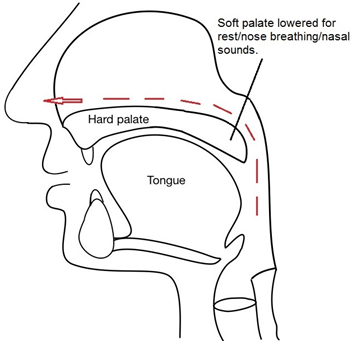A palate re-repair is an operation carried out by a cleft surgeon to help improve speech. The decision to have this operation is made jointly by the patient / parent, speech therapist and surgeon.
How does this operation help?
The operation helps speech by improving movement of the soft palate, which is the back part of the roof of the mouth. Most English speech sounds are produced through the mouth, so during speech the soft palate rises to close off the back of the nose so that air is directed through the mouth (see Figure 1).

Figure 1: diagram showing how soft palate closes off back of nose, directing air to mouth
If the palate does not close properly, it allows air to escape through the nose during speech (see Figure 2). This will give speech a nasal quality and sounds may be unclear.

Figure 2: diagram showing how air can escape if soft palate does not close correctly
For some people with a repaired cleft, the palate does not close off the back of the nose during speech because the muscles are not fully aligned or are too far forward. Modern surgical techniques can improve palate function, so it may help to perform a re-repair. This operation may also be appropriate for patients who have had no previous surgery but whose palate muscles are in the wrong position.
Speech therapy alone will not help reduce nasal speech if the palate cannot move and close properly against the back of the throat. Sometimes speech therapy is needed after the operation to help learn a new, clearer way of speaking. Your speech and language therapist will discuss this with you.
What does the operation involve?
The operation is quite straightforward: the original repair of the palate is undone, the muscles are re-positioned, then the palate is repaired once more. The patient will come into hospital on the day of the operation and will need to stay in hospital for at least one night afterwards. The throat will feel sore, similar to having tonsillitis, and the patient will need to eat a soft diet for a while. Advice will be given regarding this. Different people need different times to recover, but the patient will need to take some time off work or school following the operation.
Are there any risks / side effects?
As with all surgical procedures there are risks involved.
- Very rarely bleeding may occur following the operation requiring urgent return to theatre. This occurs in fewer than 1 in 100 patients.
- There is also a small risk (less than 1 in 10 patients) of the wound breaking down as a result of infection. This may heal by itself. If not, another operation might be needed, usually several months later.
- Breathing through the nose may also be affected at first. This is because of the re-arranged muscles and the swelling caused by the operation. If this happens, a small tube (known as a naso-pharyngeal airway) is put down the nose to help breathing for the first 24 to 48 hours after the operation. Fewer than 1 in 20 patients will require this.
The surgeon will discuss these risks with you before the operation.
It is important to be aware that speech may sound worse immediately after the operation, but should improve over the following year and become better than it was before the operation. If the operation is not successful, another surgical procedure may be available.
A review appointment will be offered at one of our clinics 4-6 weeks after surgery. A speech assessment will be carried out six months after surgery.

